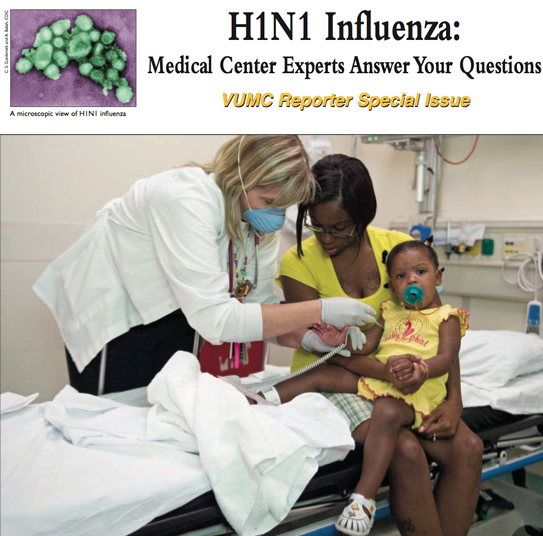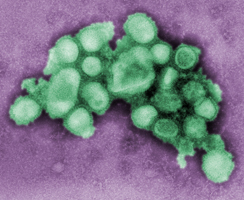
Shannon Lynch, R.N., left, takes Ka’naeja Person’s temperature while her mother Angenic Person looks on. Person brought her daughter to the Emergency Department at the Monroe Carell Jr. Children’s Hospital at Vanderbilt when she developed flu-like symptoms. (Photo by Joe Howell)
How did we get here and how bad will H1N1 be?
Be prepared. Not scared.
Those four words tell the tale of the latest incarnation of H1N1 influenza – the “swine flu.”
Truth is, no one knows how hard this flu may hit, or when it will blow over.
But as scientists and health officials learn more about this wily virus, they are becoming better prepared for the next pandemic.
Because there will be a next one.
Since the first cases of a novel influenza strain were reported in California and Mexico in March and April of this year, H1N1 has swept through nearly 200 countries, killing nearly 4,000.
By June, federal health official estimated that more than 1 million Americans had come down with H1N1 flu. Approximately 10,000 people have been hospitalized, and about 600 have died.
A typical seasonal flu in this country will kill an average of 36,000 and hospitalize more than 200,000 – mostly in people over 65, according to the Centers for Disease Control and Prevention (CDC).
But H1N1 is not your garden variety flu.
For one thing, it seems to affect younger people. Earlier this year, the CDC reported that hospitalization rates were highest in young children under 5, and the number of deaths was highest among people 25 to 49.
For another, this flu hasn’t been seen before. It’s a novel “reassortment” of four genes from influenza viruses that normally circulate in pigs, birds and humans.
H1N1 has caused mild symptoms in the majority of cases reported so far, and has remained stable and responsive to antiviral medications.
Experts worry that as it circulates in humans, the virus could pick up additional human flu genes, becoming more dangerous.

A microscopic view of H1N1
It initially was called swine flu because this new H1N1 strain was first identified in pigs. Yes, pigs come down with the flu, too, and experience the same fever, coughing and sneezing that humans do. And occasionally they can pass the virus to humans through the infected droplets they sneeze into the air.
Nobody knows exactly how this novel virus emerged, although federal agriculture officials speculate it first arose in pigs in Asia and made its way to North America in an infected human.
Today’s H1N1 influenza is genetically similar to the 1918-1919 flu, which killed millions of people worldwide including more than 500,000 Americans. But that was before anti-viral medications, antibiotics to treat bacterial co-infections and mechanical ventilators were available to prevent deaths from severe pneumonia.
H1N1 is also similar to the “swine flu” that sickened 230 soldiers at Fort Dix, N.J., in early 1976. That outbreak prompted a massive vaccination campaign which was halted after federal health officials determined the virus was not spreading widely, and the vaccine was linked to a small increased risk of Guillain-Barré syndrome, a neuromuscular disorder.
Two different influenza strains were responsible for the 1957 “Asian flu” that killed 70,000 Americans, and the 1968 “Hong Kong flu,” which killed 34,000. Like the 1918 flu before it, the 1957 variety appeared in late spring, and surged back during the following winter. Experts worry that something similar could happen this winter.
It’s important to note, however, that health officials have been planning for several years for the next influenza pandemic.
The efficiency of vaccine testing and production has been vastly improved, as evidenced by the speedy development of an effective H1N1 vaccine, which will arrive in October. Antiviral drugs have been stockpiled, as have protective masks and ventilators for the seriously ill.
Just as important, the information age has made it possible for scientists, health officials and the public to share crucial information instantly so that they combat the flu more effectively and limit its spread.
Be prepared. Not scared.













